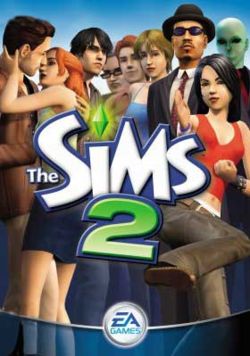 |
| https://en.wikipedia.org/wiki/File:The_sims_2.jpg |
The continued scholarship and research, as part of the Games and Learning course at UC Denver, has lead me to explore adult learning, simulations, and gender and identity as it concerns gaming. For the most part, videogames and gaming cultures have been the focus. While I searched for articles related to these topics I discovered “Gender and Identity in Game-Modifying Communities” by Hanna Wirman in the Simulation & Gaming journal as part of Sage journals published in 2014. In this article Hanna describes her research based on email interviews with THE SIMS 2 players in Finland. She also described how the media received THE SIMS 2. Finally, Hanna discussed the marginalization of THE SIMS 2 players (Wirman 2014, 71). Hanna wrote her Phd. dissertation on “Playing The Sims 2” so you can bet this article is an incredible resource on the subject. I was interested to see how Hanna presented her research findings compared to what was “nurturing” in “Nurturing Affinity Spaces and Game Based Learning” by Gee.
Compelled to learn about THE SIMS and gender
Reading about THE SIMS 2 and gender is interesting because I’m oddly situated as a white male gamer whose profession is teaching and practicing interior design, a profession dominated by women. Before that I made games for a living, a profession dominated by men (especially when I was making games), and I don’t consider myself in any way shape or form a typical white hetero normal male. I have two students this semester that have talked about playing THE SIMS before seeking a degree program for interior design. For them it was the first step into some basic design and digital literacies including modding. One of the students is male, the other is female which is also interesting. Although I’ve been a gamer and part of gaming culture all of my life, I have not looked deeply into peeling away the layers of the onion to discover what many would suggest a culture dominated, and in some ways exclusive to, white male heterosexuals. The analysis Hanna provided in this article makes it much easier see these layers and subversive dimensions as THE SIMS 2 players and modders.THE SIMS 2 in a male dominated gaming culture
Although THE SIMS 2 was a very successful game, journalist did not seem to know exactly how to handle it’s popularity. It’s a game deemed by popular culture to be dominated by the feminine domain and likened to “dollhouse” play. This poses a problem for media outlets dominated by male culture as the product is seemingly deemed “too feminine” for proper coverage (Wirman 2014, 74). Males admittedly playing, or wanting to play, THE SIMS 2 suffer emasculation at the hands of peers and society because of established gender roles associated with heteronormativity. Hanna described how one of her respondents reacts to her question:HW: Why do you think they [male school mates] haven’t played [THE SIMSHanna went on to describe how playing THE SIMS does not earn the player much credibility or “capital” as a gamer. Because the game is devalued as such by being “too feminine” and not something seemingly more masculine like a first person shooter (Wirman 2014, 76).
games] themselves?
Player 5: I assume they just haven’t bothered to try, exactly because it is considered
a “girls” game, it would make them look somehow “sissy” in their friends’ eyes (Wirman 2014, 75).
“Skinning” as modding discredited
THE SIMS 2 supports and encourages modding and there are several types of modding communities. I first read about this in “Nurturing Affinity Spaces and Game Based Learning” by Gee. As Gee refers to affinity spaces about The Sims as shining examples of nurturing affinity spaces. What I did not learn by Gee and Hayes work was how modding, in particular by skinning, in THE SIMS 2 was considered within gaming communities to be a lesser form of modding. Hanna described this as “not fitting into the hacking paradigm.” Why? Hanna seems to suggest because skinning typically only addresses visual and aesthetic appearances, often deemed a more feminine form of modding. Where as coding or otherwise dramatically changing the way a game is played by hacking is considered more masculine in nature and typified by white male culture. Thus, devaluing skinning in THE SIMS modding communities. Is it women are more inclined to enjoy skinning and be less interested in coding because skinning may be thought of as feminine domain? Is it possible girls are not as reinforced in schooling as boys in math and engineering so that they would be more inclined to coding? There may be some truth there, but ultimately, Hanna suggests modding such as skinning (in THE SIMS 2) involves “taste,” in particular taste for fashion and home decoration which lends this form of modding to be discredited due to apparent feminine traits. (Wirman 2014, 83).Marginalization of The Sims players
Hanna described the way in which the rest of the world received THE SIMS 2 similarly to the Finnish reception. THE SIMS players are marginalized both locally to Finland and globally. Most players that play THE SIMS do so exclusively which works to alienate them in more general gaming cultures (Wirman 2014, 87). Overall the description of THE SIMS 2 Hanna provided was a nice contrast to the more optimistic nurturing view Gee offers. To learn more about Hanna and to see her dissertation on THE SIMS 2, check out Hanna’s website.References & citations:
Wirman,Hanna, Simulation & Gaming 2014, Vol. 45(1) 70–92. © 2014 SAGE Publications.
Gee, James Paul; Hayes, Elisabeth; “Nurturing Affinity Spaces and Game-Based Learning.” (2008)

Comments
Post a Comment